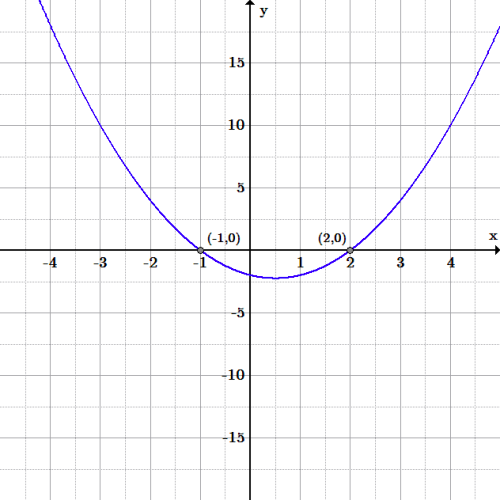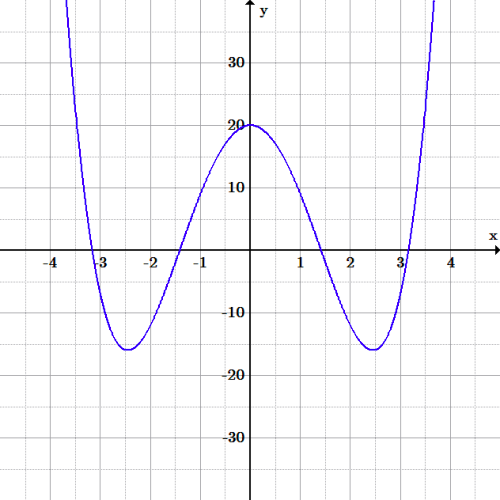Introduction to Quadratic Functions
What is a Quadratic Function?
Quadratic equations are second order polynomials, and have the form [latex]f(x)=ax^2+bx+c[/latex].Learning Objectives
Describe the criteria for, and properties of, quadratic functionsKey Takeaways
Key Points
- A quadratic function is of the form [latex]f(x)=ax^2+bx+c[/latex], where a is a nonzero constant, b and c are constants of any value, and x is the independent variable.
- The solutions to a quadratic equation are known as its zeros, or roots.
Key Terms
- dependent variable: Affected by a change in input, i.e. it changes depending on the value of the input.
- independent variable: The input of a function that can be freely varied.
- vertex: The minimum or maximum point of a quadratic function.
- quadratic function: A function of degree two.
Differences Between Quadratics and Linear Functions
Quadratic equations are different than linear functions in a few key ways.- Linear functions either always decrease (if they have negative slope) or always increase (if they have positive slope). All quadratic functions both increase and decrease.
- With a linear function, each input has an individual, unique output (assuming the output is not a constant). With a quadratic function, pairs of unique independent variables will produce the same dependent variable, with only one exception (the vertex ) for a given quadratic function.
- The slope of a quadratic function, unlike the slope of a linear function, is constantly changing.
Forms of Quadratic Functions
Quadratic functions can be expressed in many different forms. The form written above is called standard form. Additionally [latex-display]f(x)=a(x-x_1)(x-x_2)[/latex-display] is known as factored form, where [latex]x_1[/latex] and [latex]x_2[/latex] are the zeros, or roots, of the equation. These are [latex]x[/latex] values at which the function crosses the y-axis (and thus where [latex]y[/latex] equals zero). The vertex form is displayed as: [latex-display]f(x)=a(x-h)^2+k[/latex-display] where [latex]h[/latex] and [latex]k[/latex] are respectively the coordinates of the vertex, the point at which the function reaches either its maximum (if [latex]a[/latex] is negative) or minimum (if [latex]a[/latex] is positive).The Quadratic Formula
The zeros of a quadratic equation can be found by solving the quadratic formula.Learning Objectives
Solve for the roots of a quadratic function by using the quadratic formulaKey Takeaways
Key Points
- The quadratic formula is: [latex]x=\frac{-b \pm \sqrt {b^2-4ac}}{2a}[/latex], where [latex]a[/latex] and [latex]b[/latex] are the coefficients of the [latex]x^2[/latex] and [latex]x[/latex] terms, respectively, in a quadratic equation, and [latex]c[/latex] is the value of the equation's constant.
- To use the quadratic formula, [latex]ax^2 + bx+c [/latex] must equal zero and [latex]a[/latex] must not be zero.
Key Terms
- zero: Also known as a root, an [latex]x[/latex] value at which the function of [latex]x[/latex] is equal to 0.
Criteria For Use
To use the quadratic formula, two criteria must be satisfied:- The quadratic equation must equal zero; [latex]ax^2+bx+c=0[/latex]
- [latex]a[/latex] must not equal zero
Solving Quadratic Equations with the Quadratic Formula
Solutions to [latex-display]ax^2 + bx+c =0[/latex-display] can be found by using the quadratic formula [latex-display]x=\dfrac{-b \pm \sqrt {b^2-4ac}}{2a}[/latex-display] The symbol ± indicates there will be two solutions, one that involves adding the square root of [latex]b^2-4ac[/latex], and the other found by subtracting said square root. The resulting [latex]x[/latex] values (zeros) may or may not be distinct, and may or may not be real.Example
Let's take a look at an example. Suppose we want to find the roots of the following quadratic function: [latex-display]f(x) = 2x^2+5x+3[/latex-display] First, we need to set the function equal to zero, as the roots are where the function equals zero. [latex-display]0 = 2x^2+5x+3[/latex-display] Second, we need to identify the constants in the equation. The value of [latex]a[/latex] is two, the value of [latex]b[/latex] is five, and the value of [latex]c[/latex] is three. We can now substitute these values into the quadratic equation and simplify: [latex-display]x=\dfrac{-5 \pm \sqrt{5^2-4(2)(3)}}{2(2)}[/latex-display] [latex-display]x= \dfrac{-5 \pm \sqrt{25-24}}{4}[/latex-display] [latex-display]x = \dfrac{-5 \pm \sqrt{1}}{4}[/latex-display] [latex-display]\displaystyle x = \frac{-5}{4} + \frac{1}{4}[/latex], [latex]\displaystyle \frac{-5}{4} - \frac{1}{4}[/latex-display] [latex-display]x = \dfrac{-3}{4}[/latex], [latex]\dfrac{-6}{4}[/latex-display] [latex-display]x=\dfrac{-3}{4}[/latex], [latex]\dfrac{-3}{2}[/latex-display]The Discriminant
The discriminant of a polynomial is a function of its coefficients that reveals information about the polynomial's roots.Learning Objectives
Explain how and why the discriminant can be used to find the number of real roots of a quadratic equationKey Takeaways
Key Points
- [latex]\Delta =b^2-4ac[/latex] is the formula for a quadratic function 's discriminant.
- If Δ is greater than zero, the polynomial has two real, distinct roots.
- If Δ is equal to zero, the polynomial has only one real root.
- If Δ is less than zero, the polynomial has no real roots, only two distinct complex roots.
- A zero is the x value whereat the function crosses the x-axis. That is, it is the x-coordinate at which the function's value equals zero.
Key Terms
- quadratic: Of degree two; can apply to polynomials.
- zero: Also known as a root; an x value at which the function of x is equal to zero.
- discriminant: An expression that gives information about the roots of a polynomial.
The Discriminant and the Quadratic Formula
Recall the quadratic formula: [latex-display]{x=\dfrac{-b \pm \sqrt{b^2 - 4ac}}{2a}}[/latex-display] where [latex]a[/latex], [latex]b[/latex] and [latex]c[/latex]are the constants ([latex]a[/latex] must be non-zero) from a quadratic polynomial. The discriminant [latex]\Delta =b^2-4ac[/latex] is the portion of the quadratic formula under the square root.Positive Discriminant
If [latex]{\Delta}[/latex] is positive, the square root in the quadratic formula is positive, and the solutions do not involve imaginary numbers. [latex-display]x={\dfrac{-b \pm \sqrt{\text{positive number}}}{2a}}[/latex-display] Because adding and subtracting a positive number will result in different values, a positive discriminant results in two distinct solutions, and two distinct roots of the quadratic function.Zero Discriminant
If [latex]{\Delta}[/latex] is equal to zero, the square root in the quadratic formula is zero: [latex-display]x={\dfrac{-b \pm \sqrt{0}}{2a}}[/latex-display] Since adding zero and subtracting zero in the quadratic equation lead to the same outcome, there is only one distinct root of the quadratic function.Negative Discriminant
If [latex]{\Delta}[/latex] is less than zero, the value under the square root in the quadratic formula is negative: [latex-display]x=\dfrac{-b \pm \sqrt{\text{negative number}}}{2a}[/latex-display] This means the square root itself is an imaginary number, so the roots of the quadratic function are distinct and not real.Example
Consider the quadratic function: [latex-display]f(x)=x^2-x-2[/latex-display] Using [latex]1[/latex] as the value of [latex]a[/latex], [latex]-1[/latex] as the value of [latex]b[/latex], and [latex]-2[/latex] as the value of [latex]c[/latex], the discriminant of this function can be determined as follows: [latex-display]\Delta =(-1)^2-4\cdot 1 \cdot (-2)[/latex-display] [latex-display]\Delta =9[/latex-display] Because Δ is greater than zero, the function has two distinct, real roots. Checking graphically, we can confirm this is true; the zeros of the function can be found at [latex]x=-1[/latex] and [latex]x=2[/latex]. Example: Graph of a polynomial with the quadratic function [latex] f(x) = x^2 - x - 2[/latex]. Because the value is greater than 0, the function has two distinct, real zeros. The graph of shows that it clearly has two roots: the function crosses the [latex]x[/latex]-axis at [latex]x=-1[/latex] and [latex]x=2[/latex].
Example: Graph of a polynomial with the quadratic function [latex] f(x) = x^2 - x - 2[/latex]. Because the value is greater than 0, the function has two distinct, real zeros. The graph of shows that it clearly has two roots: the function crosses the [latex]x[/latex]-axis at [latex]x=-1[/latex] and [latex]x=2[/latex].Other Equations in Quadratic Form
Many equations with no odd-degree terms can be reduced to quadratics and solved with the same methods as quadratics.Learning Objectives
Use the quadratic formula to solve any equation in quadratic formKey Takeaways
Key Points
- A biquadratic equation (quartic equation with no terms of odd- degree ) has the form [latex]0=ax^4+bx^2+c[/latex]. It can be expressed as: [latex]0=ap^2+bp+c[/latex] (where [latex]p=x^2[/latex]).
- The values of [latex]p[/latex] can be found by graphing, factoring, completing the square, or using the quadratic formula. Their square roots (positive and negative) are the values of [latex]x[/latex] that satisfy the original equation.
- Higher-order equations can be solved by a similar process that involves reducing their exponents. The requirement is that there are two terms of [latex]x[/latex] such that the ratio of the highest exponent of [latex]x[/latex] to the lower is [latex]2:1[/latex].
Key Terms
- zero: Also known as a root; an [latex]x[/latex] value at which the function of [latex]x[/latex] is equal to zero.
- biquadratic: When a polynomial involves only the second and fourth powers of a variable.
- quartic function: Any polynomial function whose greatest exponent is of power four.
Example
As an example, consider the equation: [latex-display]0=x^4-12x^2+20[/latex-display] Quartic graph: Graph of the function [latex]f(x) = x^4-12x^2+20[/latex].
Quartic graph: Graph of the function [latex]f(x) = x^4-12x^2+20[/latex].We can substitute the arbitrary variable [latex]p[/latex] in place of [latex]x^2[/latex]:
[latex-display]0=p^2-12p+20[/latex-display] This equation is now solvable for [latex]p[/latex] using the quadratic formula: [latex-display]p=\dfrac {12 \pm \sqrt {(-12)^2-4\cdot 1\cdot 20}}{2\cdot 1}[/latex-display] Simplifying this, we find [latex]p[/latex] equals 2 or 10. Knowing that [latex]p=x^2[/latex], we can use each value of [latex]p[/latex] to solve for two values of [latex]x[/latex]: [latex-display]x=\pm \sqrt 2[/latex] and [latex]x= \pm \sqrt 10[/latex-display] A similar procedure can be used to solve higher-order equations. The requirement is that there are two terms of [latex]x[/latex] such that the ratio of the highest exponent of [latex]x[/latex] to the lower is [latex]2:1[/latex].Licenses & Attributions
CC licensed content, Shared previously
- Curation and Revision. Authored by: Boundless.com. License: Public Domain: No Known Copyright.
CC licensed content, Specific attribution
- Quadratic equation. Provided by: Wikipedia License: CC BY-SA: Attribution-ShareAlike.
- Quadratic function. Provided by: Wikipedia License: CC BY-SA: Attribution-ShareAlike.
- vertex. Provided by: Wiktionary License: CC BY-SA: Attribution-ShareAlike.
- quadratic. Provided by: Wiktionary License: CC BY-SA: Attribution-ShareAlike.
- quadratic function. Provided by: Wiktionary License: CC BY-SA: Attribution-ShareAlike.
- Proof of Quadratic Equation. Provided by: Khan Academy License: Public Domain: No Known Copyright.
- Quadratic equation. Provided by: Wikipedia Located at: https://en.wikipedia.org/wiki/Quadratic_equation. License: CC BY-SA: Attribution-ShareAlike.
- parabola. Provided by: Wiktionary License: CC BY-SA: Attribution-ShareAlike.
- Boundless. Provided by: Boundless Learning License: CC BY-SA: Attribution-ShareAlike.
- Discriminant. Provided by: Wikipedia License: CC BY-SA: Attribution-ShareAlike.
- Boundless. Provided by: Boundless Learning License: CC BY-SA: Attribution-ShareAlike.
- discriminant. Provided by: Wiktionary License: CC BY-SA: Attribution-ShareAlike.
- quadratic. Provided by: Wiktionary License: CC BY-SA: Attribution-ShareAlike.
- Original figure by Julien Coyne. Licensed CC BY-SA 4.0. Provided by: Julien Coyne License: CC BY-SA: Attribution-ShareAlike.
- Quartic function. Provided by: Wikipedia License: CC BY-SA: Attribution-ShareAlike.
- biquadratic. Provided by: Wiktionary License: CC BY-SA: Attribution-ShareAlike.
- Boundless. Provided by: Boundless Learning License: CC BY-SA: Attribution-ShareAlike.
- quartic function. Provided by: Wiktionary License: CC BY-SA: Attribution-ShareAlike.
- Original figure by Julien Coyne. Licensed CC BY-SA 4.0. Provided by: Julien Coyne License: CC BY-SA: Attribution-ShareAlike.
- Original figure by Julien Coyne. Licensed CC BY-SA 4.0. Provided by: Julien Coyne License: CC BY-SA: Attribution-ShareAlike.
